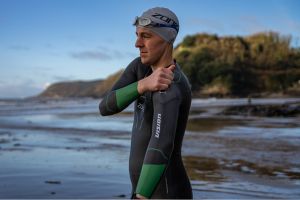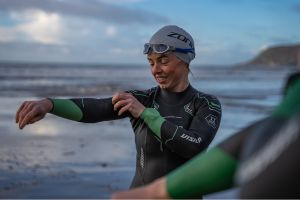By Glen Gore, former pro triathlete and current coach.
What is Brick training?
The definition for a triathlon brick session is training one discipline immediately followed by another with no significant time gap or rest period in between. In short – this prepares you for race days when 1 discipline is followed by the next until all 3 are done.
What it is not!
I once heard a folklore story about a pro cyclist who wanted to make his hill sessions a lot tougher. What he would do was pack 2 actual building bricks into a backpack, strap it on and then go and do some hill repeats. A brick session in today’s terms is certainly not this.

How will a brick session benefit me?
No matter what level you are on – brick training conditions your body to adapt to the natural rigors of what will take place on race days. It’s seemingly not that hard to go for a swim, then have a nice break after – do a cycle at lunch for instance, and then perhaps a run in the late afternoon. The body has had a chance to refuel and regain lost energy stores by allowing significant time gaps and sufficient rest in between to ensure the body and muscles are recovered and ready to work once again.
Novice/Beginner
Those that start with triathlon as a new sport will immediately tell you how their legs felt like “jelly” coming off the bike and then for them to try and run directly after. We are not just talking about running fast, just the simple act of running is hard enough when your body is not conditioned to do so.
The brick session which can take the form of a cycle – followed by a run will help you adapt to the change in using the different muscle groups.
It will also teach the novice/beginner to perhaps pace themselves better over the bike leg to ensure they have enough energy stores to complete the run section.
An important part of any triathlon is nutrition. As a novice, you need to learn this and by practicing utilizing brick sessions in training and using different methods of nutrition, you get to learn what works best for you on the bike and then on the run – before you head to the race. The longer the event – the more important those brick sessions will become.
Intermediate
Even as an experienced triathlete – with several events under the belt, the art of perfecting race days takes practice. You cannot always just rely only on race days to help you reach the next level. Training days with the brick session as a priority become very important as you go from strength to strength in your triathlon endeavors.
The more you race, the more you learn. Not every race will turn out with the perfect result. Some races might turn into total disasters, this is where you need to build in some more brick sessions at race pace simulation so you can learn from your mistakes and perhaps put them right at the very next event.
Elite
For those on the elite stage, the brick is probably the cornerstone of their training preparations. These girls and guys are racing at such high intensities where everything is fast. They need to be able to swim hard – run hard to the bike in T1 – get onto the bike and ride hard from the start, just to make the pack – sustain an incredibly hard bike leg pace and then be able to get off and run at full speed from the 1st meter.
This is all about conditioning the body to endure the rigors of this type of high-performance racing. The only way this is achieved is by simulating race day experiences and the brick session is the best way to do this.

Benefits of Brick Training for Transition
They call it the 4th discipline – Transitions. The best way to practice this is via the brick sessions. You swim first and then run to your bike – what next you ask? Well, you can go over it in your mind-head but the practical reality of being able to swim in a wetsuit – get that off as quickly as possible and then change into your cycle gear (perhaps just a helmet and cycle shoes) does take practice. The more you do it – the faster your transition becomes.
The same rule of thumb applies to the bike-to-run transition. A brick session will allow for you to practice racking that bike – taking off the helmet and cycle shoes to be replaced as fast as possible with running shoes before the run leg starts. Why you ask? I am not racing to win but merely to just finish. Yes, this may be the case but who wants to waste time in transition. Sooner or later that competitive instinct will kick in – whether it’s to better your personal best (PB) or beat a fellow club mate or family member. Undue time lost in transition can be done without and a regular brick session in either swim-to-bike or bike-to-run can help keep time-wasting to a minimum.
Brick sessions will also help improve one’s focus – no matter what level you are at. By practicing the changes (swim-to-bike / bike-to-run) that take place on race days in training, you can “train” the brain and this then almost guarantees you go into “automatic” mode on race day without even really having to think about the transition.
Brick Sessions will definitely up your skill level – the run-out from the swim exit to the start of the bike, the taking off the wetsuit which is almost an art to itself, being able to get on your cycle shoes as fast as possible and get them off in double quick time and then being able to hit your ideal running stride as quick as possible are all assisted when you get to practice those scenarios during brick training sessions.

Examples of Basic Brick Sessions for Beginners
1. Swim 200m – then get out of the (pool – lake – sea) – practice taking off the wetsuit and gearing up for the cycle and then head off onto the bike as quick as possible for a short cycle (5 to 10 mins). If you are short of space – setting up the indoor trainer next to the swimming pool will help achieve the same result. You can do this multiple times due to the short duration of the swim-cycle effort.
2. Bike-to-Run – depending on what you are training for – short distance or long distance, you can then formulate a training session to prepare you more adequately for this. If it’s an ironman (long-distance) for example – going long on the bike (3 to 4hrs) and then coming off the bike – eating something for your nutritional needs and then getting dressed-up for running and going for a longish run (8km to 12km) off the bike is a prime example. If it’s a short distance event – you may want to shorten the distances and do it multiple times for example. 5km bike ride (trainer or on the road) followed by a 1-2km run – then back onto the bike and repeat. Short and sharp will prep your body for the Sprint Race Day feelings.
A brick should be a staple of any triathlete's training program – at least once per week if you can manage it and perhaps a few more brick sessions thrown into the mix as you get closer to race day.





















